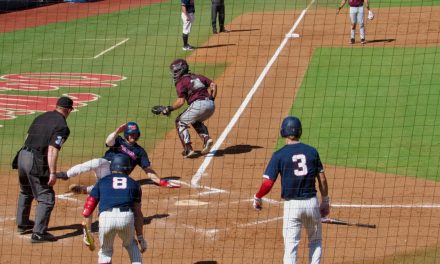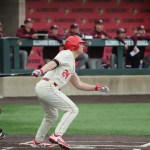
Ole Miss Rifle: There’s a lot to learn about the sport

OXFORD, Miss. — Fans of Ole Miss athletic teams are familiar with what one could refer to as the commonly known sports, such as football, basketball, baseball, softball, golf, tennis, etc. because they may have been a spectator or played a sport themselves. However, many fans may know nothing about the Ole Miss Women’s Rifle Team. We recently spoke with the team’s coach, Rachel Martin, to learn more about the sport and what the athletes do to prepare for competitions.
Martin was an assistant coach at Army and then became the head coach for the University of Nebraska. She came to Ole Miss as an assistant coach before being named head coach. A former competitor, herself, Martin won an individual NCAA Championship in Smallbore in 2015 and earned seven All-American honors throughout her competitive career.
After graduating from Nebraska in 2017, Martin moved to Colorado Springs to train at the United States Olympic Training Center. She has been a member of the USA Shooting World Cup team since 2013, representing Team USA in seven World Cups, and is a seven-time national champion. Martin also served as an alternate for Team USA at the 2021 Tokyo Olympics.
Smallbore and Air Rifle
As a frame of reference for those unfamiliar with the sport, collegiate rifle teams compete in rifle shooting events, which use a rifle to hit a target from a fixed distance.
In Smallbore competition, shooters fire 20 shots from 50 feet away in three positions: kneeling, prone, and standing.
In Air Rifle, Shooters fire all shots from 10 meters away in the standing position. To give some perspective, a standard air rifle target used in competition is 45.5mm (1.79 inches) across, with the bullseye (the “10 Ring”) being only 0.5mm in size, roughly the size of a typed period on a page. Shooters are scored based on how close their shots are to the center of the target, with a score of a perfect 10 actually amounting to 10.9.
We asked Martin how athletes get started in the sport and how she recruits for the team. “Some people do Junior ROTC in high school, and many of those programs have shooting,” she explained. “We don’t do tryouts like some of the sports do, but basically our governing body has some national competitions where everybody from high schools, 4-H teams, kind of just across the country will come and shoot in those. So, we go to those and recruit from there.”
Martin also recruits internationally and says the transfer portal has yet to impact the sport significantly, as once an athlete commits to a program, they usually remain with the team.
The uniform
In the sport of rifle, athletes wear uniforms that look uncomfortable and heavy to someone not knowledgeable about the sport.
Martin explained the purpose the uniform serves in physically supporting the athletes.
“The jacket and the pants are odd-looking if you’ve never seen them before. The uniform is stiff, and that’s for a couple of reasons. One reason is that the athlete isn’t standing; they’re kneeling. But when they get into standing, their guns are pretty heavy, and they hold them for about three hours in a competition. The way their back is curved can cause some severe damage to their back. The pants and the jacket are custom-fit to support those areas so they don’t end up having back surgery. A lot of the shooters that shot in the 1960s and 1970s have severe back and neck issues and have had to have a lot of surgeries because they didn’t have this gear. Also, when they’re shooting, because the gun is touching their body through the sight, they’ll see their heartbeat. It just kind of carries over. So, the gear is also supposed to help isolate that heartbeat a little bit. It helps them calm down and be more accurate.”
Martin on the uniform
A team sport that’s also individualized
Although the sport of rifle is a team sport, it is very individualized.
“It’s interesting,” Martin told us, “because it’s a very individual sport, even though we utilize a team score. The individual piece is how I would give an athlete 15 minutes to sight in, which is just to make sure her gun’s working and everything’s good. Then, I would tell her to start; everybody starts at the same time, and she would have an hour and 30 minutes to finish those three positions. So they’re shooting their individual matches right next to each other. It’s not like they have to tag team or even interact on the line. It’s very individual, but we count the team score at the end of the day,” she noted.
Giving the athletes the best advantage
Rifle competition isn’t just a matter of shooting at a target, and the rifle team, although it is all female, competes against coed teams. Much goes into understanding how to give athletes the best advantage possible. For this reason, Martin and her team focus on what specific rifles, ammunition, and practice protocols benefit each athlete because the more precise they can be, the better their scoring potential.
Martin explained saying, “There are certain rules, like, you can only have specific settings on it (rifle) or particular parts, but it’s very customizable. You could have one athlete shooting a 10-pound gun and another shooting an 18-pound gun. You can fit the gun very much to your body and how it works, how strong and short you are. We don’t compete just against women, and basically, the men, a lot of times, will have much heavier rifles, which gives the rifle more stability. It kind of depends on your strength. If you’re really strong and sturdy, you’re typically going to have a heavier gun just to slow the barrel down a little bit.”
Martin told us the team works with a trainer, just as in other sports. “They work with Christina Garton over in Strength and Conditioning,” Martin began.
“She trains with them three days a week and pushes them hard. They’re deadlifting, squatting, and doing all the serious stuff that all the other sports are doing. I like it when they’re stronger and can handle the heavier rifles, because I think it just helps slow the barrel down. But we have some pretty petite gals, so they will have the lighter rifles, even if they are really strong.”
Martin on the rifle team’s conditioning
Every detail matters
When those unfamiliar with the sport hear “air rifle,” they may think of a Nerf gun. Some may even think the team competes using lasers, but Martin shed some light on precisely what the sport entails by telling us, “Although we do have a laser system, it’s a pellet gun, 0.177 is the caliber for it. We do have a laser system we use for training called a SCAT system. As you’re watching her right now, you see her shooting, and then her little screen is going to pop up with the shots that she’s taking and where they’re going. The SCAT system will show you literally everything she’s doing, how she’s breathing, how she’s pulling the trigger, where she’s aiming, and what the pattern of her heartbeat is. It tells you so much, so. You can just drive, fire, pull the trigger, and it’ll record it for you. Sometimes, they’ll train without loading anything, just so they can focus on one thing at a time, but they’ll put the SCAT up there with them, so they can live fire plus do the laser system.”
Every detail matters, even down to the type of bullet used. For that reason, the athletes test ammunition to see what works best for them.
“In the beginning of the year, we do a lot of ammo testing. Because of the way the rifles are, the way that their barrels are, different lots of ammo will react differently in each barrel. You don’t know that until you test it and shoot a bunch of rounds through it. We spend about two weeks testing all their rifles and finding the best lot to make it the most accurate. There are different brands. Typically, we stick with Lapua.”
Martin on importance of ammunition testing
Competition
The rifle competition season begins in October, continues through November, resumes in January, and ends with the NCAA championship in March. The team competes in 13 meets, and although a part of the PRC (Patriot Rifle Conference), the team is still subject to NCAA rules. Ole Miss is a member of the PRC because the University of Kentucky is the only other SEC school with a rifle team, which means there aren’t enough teams to have a conference per se.
Although individual scores are important, a winning team score is the goal. We asked Martin to discuss the scoring procedure. “We have to pick five (athletes) before the meet starts, before we start shooting,” she told us. “But other teams, like Ohio State, who we shoot against, it doesn’t matter. They can pick five guys or girls, or whatever they want. The top four scores from the five that we picked count. We drop the lowest score. So, if I didn’t squad one girl, and she has the highest score on our team, but I didn’t squad her, it doesn’t matter.”
The rankings for the sport are different from most sports. Martin elaborated on how the sport is ranked saying, “The fall semester rankings are just week by week. It doesn’t add up over time. It’s only week by week. When we enter the spring, it’s our progress toward qualifying for the NCAA. So, the criteria for how we rank switches. The Coaches Association and the NCAA Rifle Committee mandate all of that. The interesting thing about our sport is we’re regulated, in a sense, by ourselves. We don’t have a lot of NCAA officials coming in or anything like that. We kind of self-regulate, which can be very efficient and great.”
An individual national champion
Hotty Toddy to a group of ladies who are excelling in their sport. And we congratulate Audrey Gogniat on firing a perfect 600 score in air rifle and becoming Ole Miss rifle’s first individual NCAA champion in any event.
THE FIRST INDIVIDUAL CHAMPION IN OLE MISS RIFLE HISTORY 👑 pic.twitter.com/o3cc2MNXS9
— Ole Miss Rifle (@OleMissRifle) March 15, 2025
Gogniat and her teammate, Gracie Dinh, led the Rebels to a runner-up team finish in air rifle. This accomplishment was the highest finish in air rifle in program history and tied for the second-best placement in any event in the national tournament for the Ole Miss Rifle program.
Rifle’s Gracie Dinh became Ole Miss’ 13th All-American this season, tap to recap her phenomenal freshman season!
— Ole Miss Rifle (@OleMissRifle) March 19, 2025
The Rebels fired a 2383, which tied for the third-highest air rifle score in school history.
Ole Miss Rifle concluded the 2024-25 season with a national champion, a runner-up finish in the NCAA’s air rifle competition and silver medals in the PRC smallbore and aggregate placement. The Rebels also set new program marks both in smallbore and aggregate scoring.
For more information about the Ole Miss Rifle Team, visit https://olemisssports.com/sports/womens-rifle.
Donna Sprabery is a former teacher, graduation coach, and academic coach for boys basketball. She graduated from the University of West Alabama with a major in business education and from Arkansas State University with a MA in Educational Leadership. A native of Meridian, MS, Donna enjoys traveling, gardening, writing, volunteer work, and cheering on the Rebels.


























